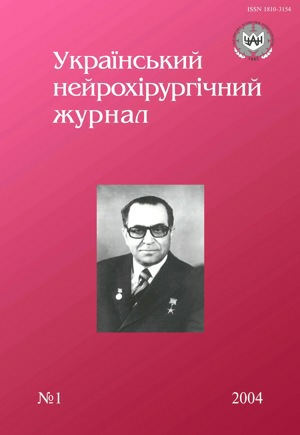New polyaxial system transpedicular fixation of thoracolumbar spine: decision-making algorithm for application, surgical technique, treatment results
Keywords:
system transpedicular stabilization of the spine, vertebral tumors, spondylolisthesisAbstract
The stabilization systems of a spine by transpedicular screws, laminar and cross hooks are the gold standard of surgical treatment various kinds pathology of a spine, postoperative oligo- or polysegmentar instability.
In 2000 the Institute neurosurgery together with the company INMED developed the new system of polyaxial fixing Coolkeeper F. In 2002 systems Coolkeeper F was further advanced in system Coolkeeper U. The new system was completely universal. This system easy to join with cervical laminar, transpedicular or transarticular fixation system.
In first spinal clinic of Institute neurosurgery the new transpedicular systems of the mark Coolkeeper F and Coolkeeper U was applied at various pathological conditions requiring transpedicular fixing of thoracic and lumbar part of a spine (48 patients). Traumatic lesions were in 25 patients, spondylosistesis in 9 patients and vertebrae tumors in 14 patients.
We achieved firm stability after operation, that has allowed to carry out early activation of patients. At control ÌRI researches are found out minimal artifacts caused by titanium, that has allowed completely visualized spine, spinal cord, cerebrospinal fluid. At control X-ray, CÒ and ÌRI studies through 3, 6 and 12 months the position polyaxial systems was stable. The systems provided reliable immobilization of the stabilized segments of a spine. Damages of systems, the displacement of screws from vertebral bodies we never have revealed. In one case carried out repeated intervention on lengthening system.
Polyaxial system are useful updating of system transpedicular fixing, is especial in case of multilevel fixing of a spine.
References
Andress H.J., Braun H., Helmberger T., Schurmann M., Hertlein H., Hartl W.H. Long-term results after posterior fixation of thoraco-lumbar burst fractures // Injury. — 2002. — №33. — P.357—365.
Bilsky M.H., Boland P., Lis E., Raizer J.J., Healey J.H. Single-stage posterolateral transpedicle approach for spondylectomy, epidural decompression, and circumferential fusion of spinal metastases // Spine. — 2000. — V.25, №17. —P.2240—2249.
Bjarke Christensen F., Stender Hansen E., Laursen M., Thomsen K., Bunger C.E. Long-term functional outcome of pedicle screw instrumentation as a support for posterolateral spinal fusion: randomized clinical study with a 5-year follow-up // Spine. — 2002. — V.27, №12. —P.1269—1277.
Csecsei G.I., Klekner A.P., Dobai J., Lajgut A., Sikula J. Posterior interbody fusion using laminectomy bone and transpedicular screw fixation in the treatment of lumbar spondylolisthesis // Surg. Neurol. — 2000. — V.53, №1. —P.2—6.
Hahn M., Nassutt R., Delling G., Mahrenholtz O., Schneider E., Morlock M. The influence of material and design features on the mechanical properties of transpedicular spinal fixation implants // J. Biomed. Mater. Res. — 2002. —V.63, №3. — P.354—362.
Kaminski A., Muller E.J., Muhr G. Burst fracture of the fifth lumbar vertebra: results of posterior internal fixation and transpedicular bone grafting // Europ. Spine J. — 2002. — V.11, №.5. — P.435—440.
Kimura I., Shingu H., Murata M., Hashiguchi H. Lumbar posterolateral fusion alone or with transpedicular instrumentation in L4—L5 degenerative spondylolisthesis // J. Spinal Disord. — 2001. — V.14, №4. —P.301—310.
Knop C., Fabian H.F., Bastian L., Blauth M. Late results of thoracolumbar fractures after posterior instrumentation and transpedicular bone grafting // Spine. — 2001. — V.26, №1. — P.88—99.
Leferink V.J., Zimmerman K.W., Veldhuis E.F., ten Vergert E.M., ten Duis H.J. Thoracolumbar spinal fractures: radiological results of transpedicular fixation combined with transpedicular cancellous bone graft and posterior fusion in 183 patients // Europ. Spine J. — 2001. — V.10, №6. — P.517—523.
Murrey D.B., Brigham C.D., Kiebzak G.M., Finger F., Chewning S.J. Transpedicular decompression and pedicle subtraction osteotomy (eggshell procedure): a retrospective review of 59 patients // Spine. — 2002. — V.27, №21. — P.2338—2345.
Paul M. Arnold, M.D., Robert D. Strang, M.D. Danielle Roussel B.S. Efficacy of Variable-Angle Screws in Transpedicular Fixation // Neurosurgical Focus. — 1999. — V.7 — Issue 6, Article 1.
Schmitz A., Schulze Bertelsbeck D., Schmitt O. Five-year follow-up of intermittent distracting rod correction in congenital scoliosis // Europ. J. Pediatr. Surg. — 2002. — V.12, №6. — P.416—418.
Thalgott J.S, Klezl Z., Timlin M., Giuffre J.M. Anterior lumbar interbody fusion with processed sea coral (coralline hydroxyapatite) as part of a circumferential fusion // Spine. — 2002. — V.15, №27. —P.518—525.
Yue J.J., Sossan A., Selgrath C., Deutsch L.S., Wilkens K., Testaiuti M., Gabriel J.P. The treatment of unstable thoracic spine fractures with transpedicular screw instrumentation: a 3-year consecutive series // Spine. — 2002. — V.15, №27. —P.2782—2787.
Downloads
How to Cite
Issue
Section
License
Copyright (c) 2004 E. I. Slynko, V. V. Verbov, A. F. Goncharenko, V. I. Derkach, V. V. Lobunko

This work is licensed under a Creative Commons Attribution 4.0 International License.
Ukrainian Neurosurgical Journal abides by the CREATIVE COMMONS copyright rights and permissions for open access journals.
Authors, who are published in this Journal, agree to the following conditions:
1. The authors reserve the right to authorship of the work and pass the first publication right of this work to the Journal under the terms of Creative Commons Attribution License, which allows others to freely distribute the published research with the obligatory reference to the authors of the original work and the first publication of the work in this Journal.
2. The authors have the right to conclude separate supplement agreements that relate to non-exclusive work distribution in the form of which it has been published by the Journal (for example, to upload the work to the online storage of the Journal or publish it as part of a monograph), provided that the reference to the first publication of the work in this Journal is included.









